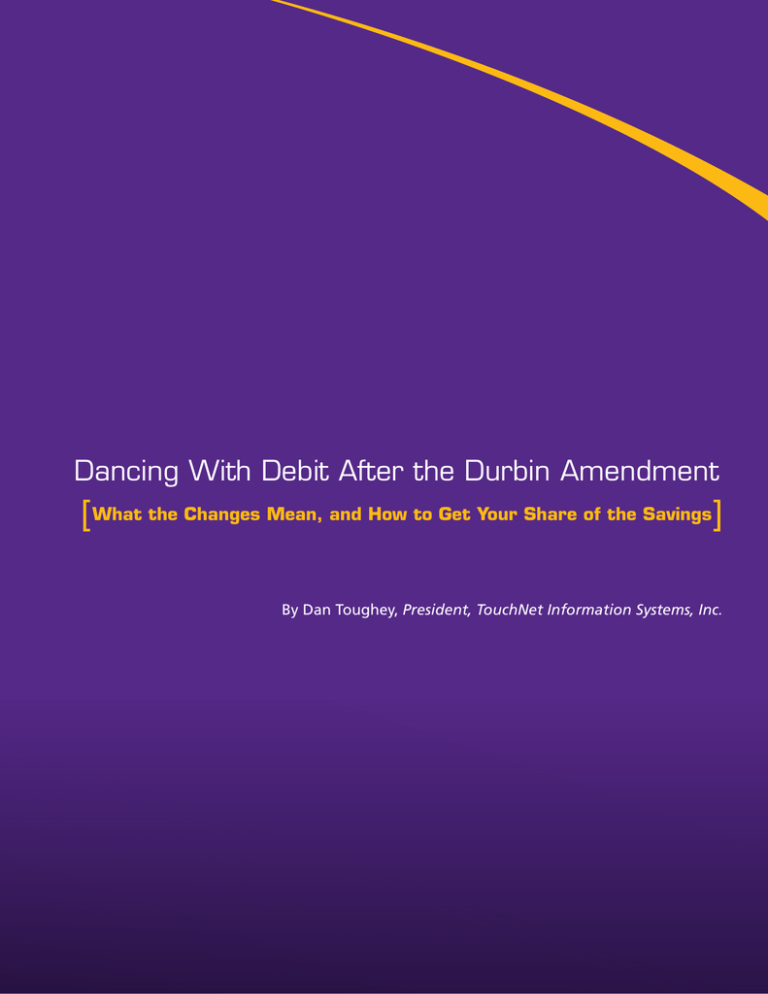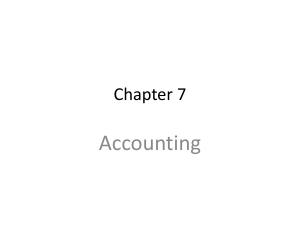
Dancing With Debit After the Durbin Amendment
[What the Changes Mean, and How to Get Your Share of the Savings]
By Dan Toughey, President, TouchNet Information Systems, Inc.
For the college business office, Oct. 1, 2011, ushered in a change in the
regulatory environment that is literally worth millions.
On that date, a federal law – the Dodd-Frank Wall Street Reform and Consumer
Protection Act – went into effect. The law, popularly known as the “Durbin
Amendment,” mandated the Federal Reserve to set reasonable and proportional
interchange fees for debit card transactions. The result is a steep reduction in
the fees that banks collect from merchants (including colleges) who accept debit
cards as payment.
Potential savings for higher education amount to tens or even hundreds of
thousands of dollars per campus; nationwide, they’re easily in the millions.
However, the law is silent on who gets the money that used to go to the banks.
It is left up to merchants, and the various payment card industry middlemen and
service providers they work with, to sort out the details on their own.
As a result, millions of dollars that used to be paid to banks is now on the table,
literally up for grabs.
In the following pages, TouchNet Information Systems will provide a detailed analysis
of the new law and its implications, and describe the steps college business
offices need to take to claim their fair share of these huge potential savings.
[
2
]
Debit Basics
The Interchange War
Chances are, your campus processes a huge volume of
Within the financial services industry, the debit card fee is
American Express, Discover and others – and it is not
Amendment was the culmination of a decade-long battle
financial transactions via payment cards – Visa, MasterCard,
uncommon for half of that card volume to be debit, not
credit, transactions.
known as the Interchange Fee. The passage of the Durbin
between merchants and banks over how those fees would
be set, and who would be in charge of regulating them.
With regard to risk, there really is no difference to the
The battle was fought at the highest levels of American
or debit-based. The merchant is guaranteed payment by the
institution in the country had a stake in the outcome, it was
college, or any merchant, whether the transaction is creditbank or other financial institution that issued the card. It is
that guarantee that makes merchants so willing to accept
payment cards.
commerce, and while virtually every merchant and financial
the biggest players who were the most vocal and involved
in the fight – leading some observers to describe the conflict,
half-jokingly, as “Wal-Mart vs. Bank of America.”
For the card issuer, it is a very different story. Every time
Before Durbin, there were two different categories of
out a small loan from the bank. The bank is risking capital
transactions: signature debit, and PIN debit.
an individual makes a credit card purchase, they are taking
by covering that purchase until the cardholder pays the bill.
debit card interchange fees, based on two forms of debit
The fee that merchants pay to banks to participate in their
PIN debit requires the cardholder to provide a Personal
risk of not being paid by the cardholder.
like an ATM transaction. That adds an extra layer of fraud
card networks isn’t pure profit; it also helps cover the bank’s
From a risk perspective, a debit card transaction is very
different. A debit card draws from money the cardholder
already has on deposit in the bank. Covering that purchase
Identification Number before a transaction is processed, just
protection, reducing bank risk even further. Given that extra
level of protection, the interchange rates in effect prior to Oct. 1
were generally lower and often capped.
presents virtually no risk to the bank. Potential fraud is the
Signature debit is like a credit card transaction. Without the
hardly begins to rise to the dollar level of unpaid credit
interchange fees were not capped and banks set them at
only real source of risk, and while fraud is a problem, it
card debt.
That difference in risk exposure is at the heart of the
need for a PIN, the risk of fraud is higher. Signature debit
whatever point they thought was justified – and acceptable
to customers.
regulatory issue that resulted in passage of the Durbin
As debit card usage grew steadily, however, interchange fees
develop and enforce new limits on the per-transaction
banks. To drive more signature debit revenue, more and more
Amendment. The law directed the Federal Reserve to
fees banks charge for debit card use. The justification for
the change was that debit card fees do not have to cover
unpaid debt risk the way credit card fees must.
As reasonable as that change sounds, this one was a long
time coming.
came to represent a large and growing revenue source for
banks began converting their debit cards to credit card look-
alikes stamped with a VISA or MasterCard logo, rather than the
individual bank-specific debit cards that used to dominate.
The idea was to promote greater use of
signature debit. “Use it just like a
[
3
]
credit card,” was the common marketing theme. While
the fraud risk was higher, so was the revenue from the
interchange fees – paid by the merchant, not the cardholder.
That’s how “credit or debit” became as common as “paper
or plastic” as a checkout-line question, even though the
question itself was inaccurate. It was all debit; the banks
just convinced people to refer to signature debit as “credit.”
Eventually, debit cards grew to become the largest non-cash
form of payment in the country.
Meanwhile, merchants started to ask some pointed questions
of their own: about the justification for those high fees
they were paying for debit transactions. Both sides sought
changes in the law from Congress to better serve their
competing interests.
“the real impact
will be felt on
higher-amount
transactions …”
In the end, Wal-Mart prevailed over Bank of America. The
Durbin Amendment became law. Interchange fees came down.
And the fee difference between signature and PIN debit has
been eliminated; both now follow the same formula.
Banks are now scrambling for ways to make up the lost
revenue from interchange. Don’t be surprised if the same
banks that for years urged customers to pay with signature
debit now change their tune and start promoting credit card
purchases instead.
Cents-per vs. Per-cents
The key to the impact of Durbin is that the interchange
fee for debit card transactions has been changed in a truly
fundamental way.
Under the old system, the fee for each transaction was based
on a percentage of the transaction amount. Buying a fancy
coffee yielded a few pennies for the bank, but buying a flatscreen TV generated more than $10 in fees for the bank.
Again, as a credit card transaction, such a discrepancy
makes sense from a risk perspective. But if you’re just
[
4
]
looking at the actual cost of processing the transaction, the
amount doesn’t matter.
The new Durbin rules reflect this. The new formula is
complex, but the biggest piece of the interchange fee is now
a flat rate of 21 cents per transaction. There still will be a
percentage fee applied as well, to account for fraud risk, but
There are additional complications. Banks with less than
$10 billion in assets are exempt from the new rules. Most
debit cards in the U.S., however, are issued by banks that are
covered by the new rules. Most colleges that distribute debit
cards to their students, on the other hand, do so in partnership
with banks that are under the $10 billion threshold.
it is much lower than before: .05 percent, or five cents on a
Some forms of prepaid debit cards are also exempt.
According to the Federal Reserve, the average debit card
Man in the Middle
into effect Oct. 1, the bank’s fee for that transaction will
So, Durbin is on the books, the bank fees are capped, and all
But the real impact will be felt on higher-amount
Not so fast.
transaction – such as a partial tuition payment – would cost
Colleges do not generally pay interchange fees directly to
That’s a savings factor of greater than 90 percent.
an intermediary; the third party’s job is to process the
$100 transaction.
transaction is $38. Under the new fee structure, which goes
drop from 45 cents to 24 cents.
transactions. Under the old fee structure, a $1,000
a college $10; under the new rules, that drops to 72 cents.
is right with the world. Just sit back and count the money?
banks. Instead, they hire a third-party processor to act as
transactions and route them to the many, many different
issuing banks that provide the cards that students, alumni
$1,000 Tuition
Transaction
Before
Durbin
After
Durbin
Interchange for card issuer (1%)
$10
$.72
Card processor fees (20 bps)
$2
$2
and guests use to make on-campus purchases.
These merchant service providers, or MSPs, collect the
interchange from the colleges and pass it on to the various
banks. They also charge a fee to cover their costs and run
a profitable business. Those fees, combined, are referred
to as the Discount Fee, which is what colleges and other
Total discount fees
$12
$2.72
(example for illustration purposes)
This is why this development is so significant for colleges.
They tend to generate a large number of high-dollar-amount
transactions: tuition payments, season tickets for football, a
semester’s worth of books at the bookstore.
Potential savings for higher education amount to tens
or even hundreds of thousands of dollars per campus;
nationwide, they’re easily in the millions.
merchants pay; interchange is the single biggest piece, by
far, of the overall cost of the MSP.
In most cases, the business relationship between the MSP
and the merchant (or college) is covered by a contract.
The discount fee specified in that contract is not legally
affected by the Durbin Amendment. The merchant service
provider is therefore legally entitled to reap a windfall
from the changes. It can continue to charge the
merchant or college the same rate as before,
pay a much smaller cut to the bank, and
keep the difference.
[
5
]
What You Need to Do
Step one for colleges is to take a long, hard look at their
merchant service contract. Many such contracts have an
opt-out or buyout provision; if so, schools need to exercise
their opportunity to opt out of the current deal and
renegotiate their agreements. Even if there is a financial
penalty involved, the savings potential is such that in
many cases the penalty is well worth it.
“With more than half
Even if your contract doesn’t include such a provision,
you can still negotiate from a position of strength.
The college business office should tell the merchant
of VISA transactions
service provider you know the rulebook has changed
now being debit
or the provider ’s chances of renewing the deal when
rather than credit,
schools can give
convenience fee
arrangements
another look.”
and the provider ’s fees have dropped dramatically.
You say you want a new deal that reflects the new reality,
it expires are nil. Odds are the provider will be willing
to deal.
Second, insist on a plan that passes the actual charge from
the bank directly to the college – with an additional fee on
top to cover the service provider’s expenses. That is known
as a “cost plus interchange” formula.
As you negotiate, make sure the new agreement
unbundles credit and debit card transactions. In the past,
contracts often called for a flat-rate fee to cover all
transactions, both credit and debit. Such deals are no
longer in your favor.
How Convenient
Another important side effect of the Durbin changes is
that convenience-fee-based credit card payment systems
are now back on the table. Up to now, some campuses
have declined to participate in convenience-fee systems,
despite the substantial cost savings they offer, because
many schools felt VISA’s convenience fee rules were
unworkable for higher education purposes.
[
6
]
Campus merchants typically pay a fee of about 2 to 2.5
that enable you to ensure that all
– again, to cover the financial risk of the loan. A convenience
to bookstore purchases – are processed the way
percent of the transaction amount for accepting credit cards
fee vendor acts as the college’s agent, accepting the payment
and charging the fee back to the student. Georgia Tech, for
example, estimates that it saves about $1.7 million a year
in fees by using a convenience fee vendor.
Other schools, however, did not want to deal with the hassle
of having to tell students and their families, “Sorry, we can’t
accept VISA.” Now, under Durbin rules, the schools can accept
VISA debit card payments at a significantly reduced cost.
debit transactions – from tuition payments
you want them for maximum savings.
The best business software packages can recognize
that a payment card is a debit card, rather than a credit
card, and prompt the customer to enter a PIN. We may
also see a move to PIN-based online transactions, so you’ll
want to be working with a technology partner that is fast
and flexible enough to react to changes and allow you to
leverage the opportunities that arise.
With more than half of VISA transactions now being
There are other ways that highly capable and flexible software
arrangements another look. “We can accept VISA debit
transactions through competing communications networks is
debit rather than credit, schools can give convenience fee
cards” is a much easier sell.
The Technology Factor
Given the now-significant gap between the costs of credit
platforms can help cut costs in Durbin’s wake. Routing PIN debit
just one example. VISA used to require merchants to use their
internal network; now, under Durbin, that’s not allowed, and
competition may drive that cost down as well. The catch is that
the college’s software has to be intelligent enough to route each
transaction through the lowest-cost system available.
card transactions vs. debit card transactions, schools should
At TouchNet, we’re committed to being your partner and
for large-amount transactions. For example, a $1,000 tuition
if you find any of this confusing or if you want assistance
seriously consider offering a discount for using debit cards
payment can be reduced to $995 if made with a debit card or
paper check instead of a credit card. Even with the discount,
the school will come out ahead on the fee difference.
In fact, colleges can benefit from channeling as many
transactions as possible to debit rather than credit. Business
office technology can play an important role in that process.
helping you navigate these important changes. Contact us
in reviewing your merchant agreement(s). Here’s a special
e-mail address to use: debit-watch@touchnet.com.
About the Author
Dan Toughey, president of
TouchNet Information Systems, Inc.
It’s also possible that banks may start to offer an even lower
interchange rate for PIN debit over signature debit, or offer
PIN-based incentives in other ways, now that higher-risk
signature debit can no longer be used as a cash cow. Under
the new rules, you now have the power to decide how you
want each debit transaction processed. You’ll want to make
sure all your debit transactions are processed in the lowest-
(www.touchnet.com) since 1989,
has guided the company to marketleader status in automated
commerce management solutions
for higher education. A graduate
of Augsburg College in Minneapolis, Minn., he formerly
worked for leading firms in the financial services industry.
priced format; there are business-office software packages
[
7
]
TouchNet Information Systems, Inc.
15520 College Blvd., Lenexa, KS 66219
1.800.869.8329 • 913.599.6699
www.touchnet.com
© 2011 TouchNet Information Systems, Inc. All rights reserved. TouchNet, TouchNet logo, Set the Curve, U.Commerce, PayPath, and Seek-N-Secure are registered trademarks.
Other TouchNet products are trademarks or service marks of TouchNet Information Systems, Inc.




